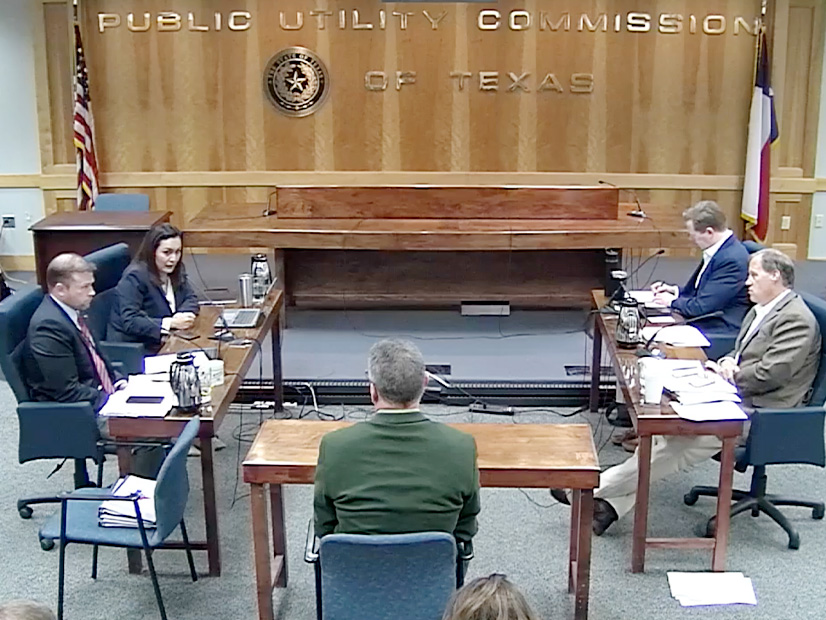
The clock continues to tick on the Texas Public Utility Commission’s self-imposed December deadline for the ERCOT market redesign, with the regulators no closer to consensus than they were during their last design work session.
During the PUC’s fifth work session on a new market design Thursday, PUC Chair Peter Lake again brought up a load-serving entity obligation as a means to provide firm dispatchable generation in a market flush with renewable resources. Again, he faced pushback from the other three commissioners concerned over the mechanism’s effect on ERCOT’s “crown jewel” of a retail market. (See Texas PUC Nears Market Redesign’s Finish Line.)
Lori Cobos, who was CEO of the consumer-oriented Office of Public Utility Counsel before being appointed to the PUC, reminded the commission that ERCOT’s market was deregulated more than 20 years ago to take investment risk away from consumers served by regulated utilities and place it on investors.
 PUC Chair Peter Lake | Texas PUC
PUC Chair Peter Lake | Texas PUC“I feel that we’re taking that risk and putting it right back on the consumers and steering away from the reliability principles of [the 1999 legislation],” she said. “We must be vigilant and ensure we’re not weakening the market and putting the risk back on consumers. I continue to believe we need to move in a strategic, targeted manner while we take the time to thoughtfully, deliberatively, holistically evaluate all long-term options that must be fully evaluated and considered before pulling the trigger.”
“I’m trigger happy. The grid is demanding we be trigger happy,” said Lake, who often refers to legislation passed earlier this year in the wake of February’s Winter Storm Uri and the compliance burden it places on the PUC.
The LSE obligation addresses resource adequacy concerns by introducing a formal reliability standard and a mechanism to ensure sufficient resources meet this standard. (See Study Suggests Texas LSEs Can Provide Reliability.)
In an October memo, Lake suggested parameters for the LSEs’ obligation. They would need to have firm resources to meet 50% of their forecast net peak load three years out, 70% two years out, 90% one year out and 100% one month out.
“I’m worried about suppressing the animal spirits of the real-time market,” Commissioner Will McAdams said, calling for market flexibility to price-responsive behavior.
“We’ve been asking for ideas and gotten a very narrow scope of ideas,” Lake said. “An LSE obligation is not a risk on consumers; it’s a risk on companies that have promised to provide power to those consumers. Those retail companies also have investors. In no way would an LSE obligation move risk to consumers.”
To back up his point, Lake recounted a recent meeting he had with a retailer, who said “we don’t provide power; we sell things,” Lake said. “Which is not, in my mind, providing reliable power to our consumers or businesses.”
“I have no problem adding some risk [on LSEs],” he said.
Capacity Market in Disguise
Attorney Catherine Webking, general counsel for the electric retailer lobbying group Texas Energy Association for Marketers, said her constituents have “very grave concerns” about the LSE obligation’s capacity requirements.
“That’s not to say that [retail electric providers] don’t hedge and buy firm power … they do, today,” she said. “It still looks to the LSE to demonstrate a capacity procurement, specific to a physical resource, which is not how it’s done today.”
Webking said that qualified scheduling entities (QSEs) procure resources on behalf of the retail electric providers (REPs) in ERCOT’s market.
“Ultimately, a physical obligation is there, but the individual REP does not necessarily have to demonstrate which unit and which megawatts at that resource are being procured,” she said. “As I understand the proposal, the LSE would have to say I understand these physical resources are where I’m buying power. It’s still tied to physical generation and physical capacity of that unit. There’s no revenue stream with that forward capacity purchase.”
Independent consultant Alison Silverstein, who advocates for demand response and energy efficiency measures, said the LSE obligation “looks pretty much like a capacity market” in disguise.
“It also requires both the commission and ERCOT do a significantly better job of planning and forecasting than either of them have shown the capability of doing to date,” she said.
Stoic Energy’s Doug Lewin, who has been live tweeting the PUC’s recent work sessions, lamented other solutions that have been sidelined in favor of the LSE obligation’s discussion.
“They’ve spent so much time talking about the [LSE obligation], which won’t make a difference for a couple of years anyway,” he told RTO Insider. “They could have implemented some of the other things that could have been implemented much faster, like demand response and targeted energy efficiency.”
In drawing the discussion to a close, Lake said, “It’s clear we still have a lot of work to do.”
He asked the commissioners to “put pen to paper” before the next work session and provide their thoughts on firming mechanisms, a reliability adder, and other market changes.
The PUC delayed decisions on revisions to the operating reserve demand curve and other changes until The Brattle Group completes an assessment of alternative ORDCs. An overview of the study dropped Friday.
Brattle suggested a $10/MWh adder to cover start-up costs of marginal resources could be imposed around 5,550 to 5,800 of online reserves to encourage self-commits and reduce the need for reliability unit commitments.
The commission tabled a rulemaking that will lower the high system-wide offer cap (HCAP) from its current $9,000/MWh to $4,500/MWh to time its publication with changes to the ORDC. The HCAP was dropped to $2,000/MWh after February’s winter storm and is set by rule to revert back to $9,000/MWh on Jan. 1 (52631).



